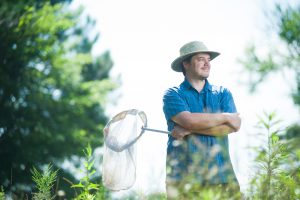
TUSCALOOSA, Ala. — Researchers at The University of Alabama will lead a genetic investigation into whether the environment influences cold tolerance in bumble bees.
“The goal is to use genomics, chemistry and physiology to predict how bumble bees survive the dramatic differences in environmental conditions across elevation gradients,” said Dr. Jeff Lozier, UA associate professor of biological sciences. “Something is maintaining a difference in these populations over relatively short distances, so we are trying to figure out what.”
Lozier is part of group of scientists across the country who will examine this phenomenon as part of a recently awarded $1.4 million grant from the National Science Foundation.
On the same mountain, it seems that bumble bees in the colder, higher elevation survive temperatures below freezing, while the same species in the warmer, lower elevation cannot.
Why and how this happens is not clear, Lozier said. Their genetic information is the same, but it is possible the environment influences which genes are expressed, or turned on or off. One way genomes are influenced by external factors is by a process known as epigenetics. It is increasingly seen as a potent mechanism in how organisms respond to different environments and stresses in situations ranging from human diseases to, in this study, bumble bees living below freezing temperatures.
“We know there is potential for epigenetics to have a strong effect on these bumble bees, so why not something that helps them withstand environmental changes?” Lozier said.
Epigenetic processes involve chemical modifications of genetic information but do not change how that information is arranged in an organism. Epigenetic changes can be passed down across generations, so it is possible the bees higher up the mountain have adapted to keep working through colder temperatures based on prior environmental exposure, Lozier said.
The researchers will study lab-reared bees and bees collected from elevations along the Cascade Mountains in Oregon, which will be kept at the University of Wyoming. There Dr. Michael E. Dillon, associate professor of zoology and physiology, is heading up a partnered NSF grant.
Dillon’s focus will be on the physiology research, chilling the bees and measuring cold tolerance and its plasticity for bees from different populations.
A bumblebee experiencing a cold temperature may stop foraging, mating or pollinating flowers. A first sign is reduced activity. The bee may eventually stop grooming, cease walking and stop moving its antennae, Dillon said.
The research is practical because bumblebees and other bee species are in decline worldwide, researchers said.
“We know climate plays a role. It’s not the only factor, but it’s a factor,” Dillon said. “Understanding their temperature tolerance will be really important in determining how they will adapt to changing temperatures.”
Dr. Janna Fierst, UA assistant professor of biological sciences, will develop computer models to analyze and test how the environment can influence genetic expression. The analytical models will allow the researchers to spot patterns and tease out factors of epigenetics.
“We’ll have billions of genetic sequences for these different bees, and a computational model will help identify emergent properties to find patterns we don’t know are there,” Fierst said.
Along with colleagues in Wyoming, other team members from the project are at Ohio State University.
At UA, the grant will support postdoctoral researchers, graduate students and undergraduate research assistants.
Contact
Adam Jones, UA communications, 205-348-4328, adam.jones@ua.edu
Source
Dr. Jeff Lozier, 205-348-2754, jlozier@ua.edu
